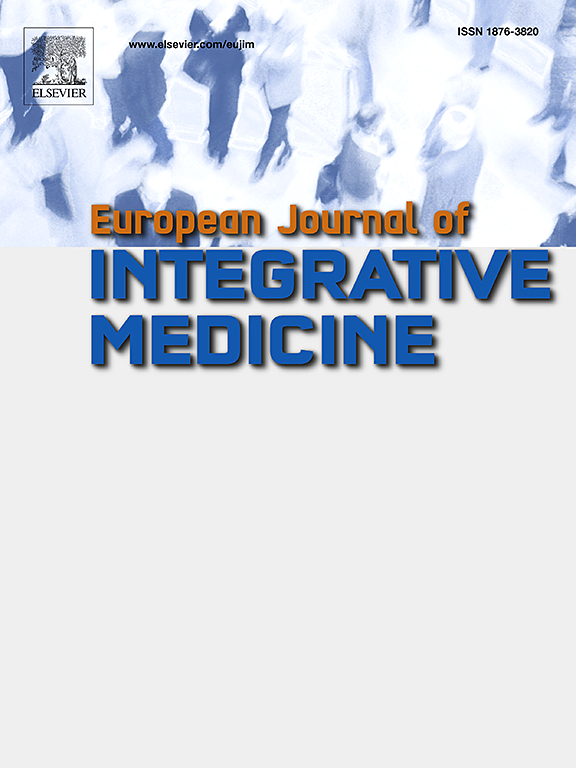Baihu Jia Renshen decoction for type 2 diabetes: A multi-method study combining a systematic literature review, Delphi survey, and network pharmacology
IF 1.7
4区 医学
Q3 INTEGRATIVE & COMPLEMENTARY MEDICINE
引用次数: 0
Abstract
Introduction
Baihu Jia Renshen Decoction is composed of Gypsum Fibrosum, Anemarrhenae Rhizoma, Oryza Sativa L., Glycyrrhizae Radix et Rhizoma and Ginseng Radix et Rhizoma. It is recommended by five guidelines in China for the treatment of type 2 diabetes mellitus (T2DM). However, evaluations of its efficacy involve a diverse range of outcomes. This multi-method study aims to identify clinical outcomes that traditional Chinese medicine (TCM) practitioners consider both predictive of T2DM progression and responsive to the formula, and to explore the herbal formula’s mechanisms of action on these outcomes.
Methods
We searched eight databases and collated clinical outcomes reported in randomized controlled trials, as well as signs and symptoms of clinical response listed in TCM clinical guidelines. A panel of eight TCM clinicians participated in three rounds of Delphi surveys to select the most important outcomes. Finally, overlapping genes between responsive outcomes-related genes and the targets of formula were obtained. Based on the enrichment analysis results, the“herb-compound-target-pathway-outcome” relationship was constructed to show how the formula affect clinical outcomes.
Results
Seventy-six outcomes were shortlisted from the literature, from which consensus was reached in the Delphi survey on eight. These were xerostomia, polydipsia, preference for cold drinks, red tongue, dry tongue, tongue coating dryness, large pulse and fasting blood glucose (FBG). Fifteen overlapping gene targets were identified. Based on enrichment analysis, we hypothesized that diosgenin, nicotinic acid, and anhydroicaritin from Anemarrhenae Rhizoma may act on SOD1, PPARGC1A, CHRM3, modulating AMPK signaling pathway and thereby influencing xerostomia and tongue dryness. The 29 components were found to act on PPARG, PPARGC1A, SHBG, etc, regulating insulin signaling pathway and the AMPK signaling pathway, ultimately affecting FBG.
Conclusion
Based on the network pharmacology studies, the potential mechanisms of action of Baihu Jia Renshen Decoction on the eight core clinical outcomes are as follows. Anemarrhenae Rhizoma may regulate dryness of the tongue and xerostomia. Anemarrhenae Rhizoma, Ginseng Radix et Rhizoma and Glycyrrhizae Radix et Rhizoma may modulate FBG levels. Further research is needed to explore the formula’s mechanisms of action for the remaining five outcomes and T2DM.
白虎加人肾汤治疗2型糖尿病:系统文献综述、德尔菲调查、网络药理学相结合的多方法研究
白虎加人肾汤由石膏纤维、知母、薏米、甘草、人参组成。在中国治疗2型糖尿病(T2DM)的五项指南中推荐使用。然而,对其疗效的评估涉及各种各样的结果。这项多方法研究旨在确定中医医生认为预测T2DM进展和对方剂反应的临床结果,并探讨中药方剂对这些结果的作用机制。方法检索8个数据库,整理随机对照试验报告的临床结局,以及中医临床指南中列出的临床反应体征和症状。一个由8名中医临床医生组成的小组参与了三轮德尔菲调查,以选择最重要的结果。最后,得到了反应结果相关基因与配方靶点之间的重叠基因。根据富集分析结果,构建“草药-化合物-靶点-途径-结果”关系,显示复方对临床疗效的影响。结果从文献中筛选出76个结果,其中8个结果通过德尔菲调查得到一致。这些症状包括口干、渴渴、喜欢喝冷饮、舌红、舌干、舌苔干燥、脉搏大和空腹血糖(FBG)。确定了15个重叠的基因靶点。基于富集分析,我们推测从鸭茅中提取的薯蓣皂苷元、烟酸和水杨桃素可能作用于SOD1、PPARGC1A、CHRM3,调节AMPK信号通路,从而影响口干和舌干。发现29种成分作用于PPARG、PPARGC1A、SHBG等,调控胰岛素信号通路和AMPK信号通路,最终影响FBG。结论基于网络药理学研究,白虎加人肾汤对8项核心临床疗效的潜在作用机制如下:知母可调节舌燥和口干。参、参、甘草均可调节FBG水平。需要进一步的研究来探索该配方对其余五种结果和T2DM的作用机制。
本文章由计算机程序翻译,如有差异,请以英文原文为准。
求助全文
约1分钟内获得全文
求助全文
来源期刊

European Journal of Integrative Medicine
INTEGRATIVE & COMPLEMENTARY MEDICINE-
CiteScore
4.70
自引率
4.00%
发文量
102
审稿时长
33 days
期刊介绍:
The European Journal of Integrative Medicine (EuJIM) considers manuscripts from a wide range of complementary and integrative health care disciplines, with a particular focus on whole systems approaches, public health, self management and traditional medical systems. The journal strives to connect conventional medicine and evidence based complementary medicine. We encourage submissions reporting research with relevance for integrative clinical practice and interprofessional education.
EuJIM aims to be of interest to both conventional and integrative audiences, including healthcare practitioners, researchers, health care organisations, educationalists, and all those who seek objective and critical information on integrative medicine. To achieve this aim EuJIM provides an innovative international and interdisciplinary platform linking researchers and clinicians.
The journal focuses primarily on original research articles including systematic reviews, randomized controlled trials, other clinical studies, qualitative, observational and epidemiological studies. In addition we welcome short reviews, opinion articles and contributions relating to health services and policy, health economics and psychology.
 求助内容:
求助内容: 应助结果提醒方式:
应助结果提醒方式:


